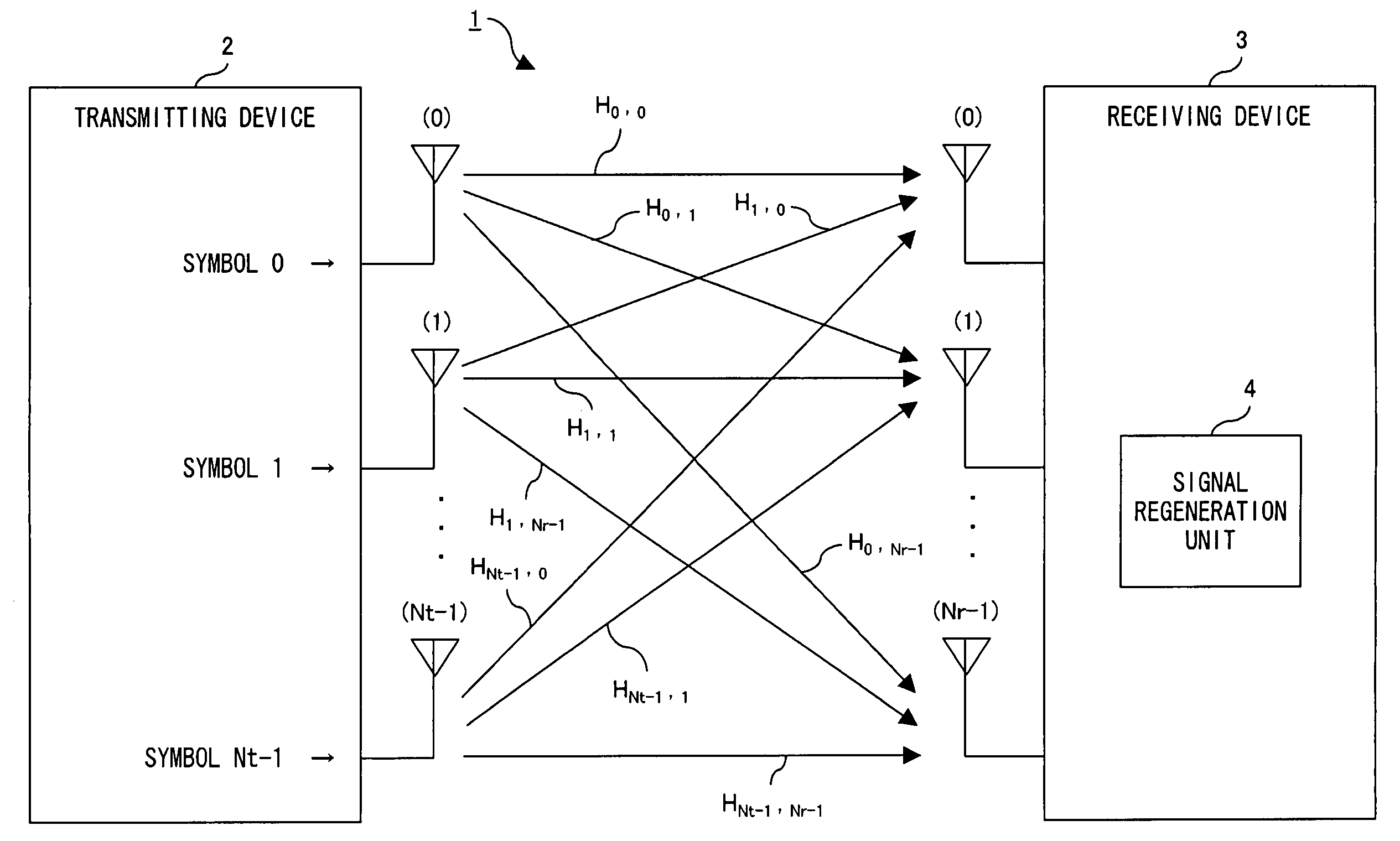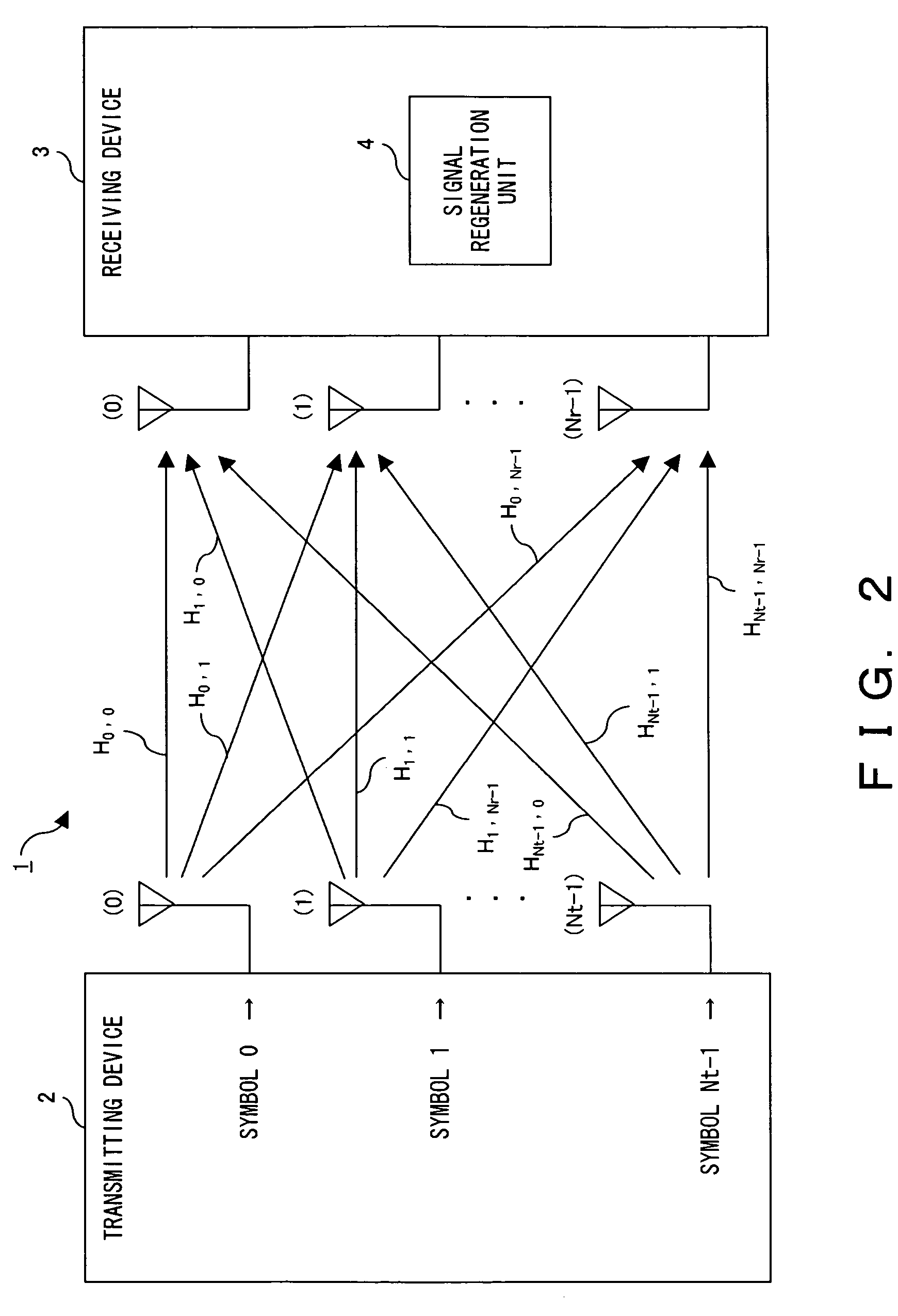Signal receiving method in MIMO system and device therefor
a technology of mimo and receiving method, which is applied in the field of receiving method in mimo system and device therefor, can solve the problems of low decoding performance, large computational effort, and noise in each receiving antenna, and achieve excellent decoding performance and suppress the complexity of decoding processing.
- Summary
- Abstract
- Description
- Claims
- Application Information
AI Technical Summary
Benefits of technology
Problems solved by technology
Method used
Image
Examples
embodiment 1
[0137]In Embodiment 1, the algorithm according to the present invention is applied to MIMO-OFDM system. The OFDM is, for example, described in the Document 5 (R. Van Nee and R. Prasad, “OFDM For Wireless Multimedia Communications”, Artech House Publishers, 2000) and the Document 6 (L. J. Cimini, “Analysis and simulation of digital mobile channel using orthogonal frequency division multiple access”, IEEE trans. Comm., pp. 665-675, 1995), and the MIMO-OFDM is described in the Document 7 (A. Van Zeist and al., “Implementation of a MIMO OFDM-based wireless LAN system”, IEEE Trans. Signal. Process. 52, No 2, 2004, pp. 483-494). Here, the outlines are described.
[0138]OFDM is a technology which realizes high-speed transmission by lowering the rate of each sub-carrier and increasing the number of low-rate sub-carriers. Frequency bandwidth is divided into a plurality of small ranges which are each used as sub-carries. Sub-carriers are orthogonal to each other. In order to obtain this propert...
embodiment 2
[0157]In Embodiment 2, the algorithms according to the present invention are used in a multi-carrier CDMA system. The multi-carrier CDMA technology is incorporated into the OFDM modulation for multi-access. In addition, the multi-carrier CDMA is described, for example, in the Document 8 (Yee N., J. P. Linnartz and G. Fettweis, “Multi-carrier CDMA in indoor wireless radio networks”, IEICE Trans. Comm., E77-B pp: 900-904, July 1994) and Document 9 (S. Abeta, H. Atarashi and M. Sawahasgi, “Performance of Coherent Multi-Carrier / DS-CDMA and MC-CDMA for Broadband Packet Wireless Access”, IEICE Trans. Commun., vol. E84-B, No. 3 March 2001).
[0158]FIG. 15 is a configuration diagram of a multi-carrier CDMA transmitter. The configuration and operations of the transmitter are described below, in reference to the diagram.
[0159]The multi-carrier CDMA signal is generated as below-mentioned. Namely, the binary data is encoded (convolutional coding or turbo coding etc.) and modulated (BPSK, QPSK, 16...
embodiment 3
[0166]In Embodiment 3, the algorithm according to the present invention is used as a time domain equalizer in a single carrier communication system. In this case, the transmitter, as shown in FIG. 17A, comprises a serial / parallel converter for creating Nt data streams from the input data, Nt encoders for individually encoding each data stream, Nt modulators for individually modulating each data stream, and Nt transmitting antennas for individually transmitting each modulated signal.
[0167]The receiver, as shown in FIG. 17B, comprises Nr receiving antennas, the MIMO processing unit 13, Nt demodulators for demodulating the output of the MIMO processing unit 13, and Nt decoders for decoding the demodulated signals. The MIMO processing unit 13 operates as a time domain equalizer by executing the algorithms according to the present invention and outputs the estimated values of the Nt transmitted symbols from the Nr received signals.
PUM
 Login to View More
Login to View More Abstract
Description
Claims
Application Information
 Login to View More
Login to View More - R&D
- Intellectual Property
- Life Sciences
- Materials
- Tech Scout
- Unparalleled Data Quality
- Higher Quality Content
- 60% Fewer Hallucinations
Browse by: Latest US Patents, China's latest patents, Technical Efficacy Thesaurus, Application Domain, Technology Topic, Popular Technical Reports.
© 2025 PatSnap. All rights reserved.Legal|Privacy policy|Modern Slavery Act Transparency Statement|Sitemap|About US| Contact US: help@patsnap.com



